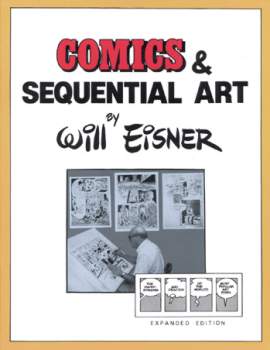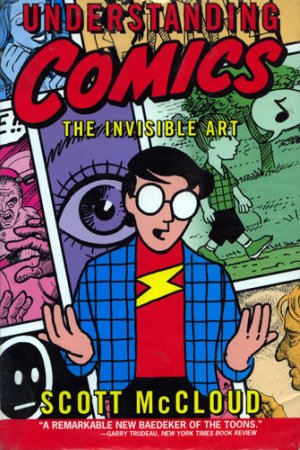Comics /
Spotlight /
Knowledge and Scholarship
Understanding Academic Research and the Comic Book
By Hervé St-Louis
January 18, 2009 - 00:40
This is a light essay asking a few questions about something I’ve been asking myself recently. I’ve been thinking seriously about the study of comic books, how it’s been handled, begun rereading my classics studies of sequential art – the scholarly designation used for comic books. I’ve been asking myself about whether there is a language inherent to the comic book when it is time to study this medium. I’m not sure.
Why is a language of study inherent to the comic book important anyway? Well, comic books are not novels, they are not movies. Sequential art is an art form that predates many. It clearly communicates and has rules and methods of its own. Hence, borrowing academic models and theories from other media and art forms will, one presupposes, always come short of being able to explain, describe and understand sequential art.
The study of the comic book has more often been separated as form versus contents analyses. When it comes to form, one of the major books was Will Eisner’s
Comics and Sequential Art. There he redefined comic books as sequential art and made it possible for other forms, such as the storyboard to be included in latter studies. The second major book in North American circuits to study the comic book was
Understanding Comics by Scott McCloud. Here, McCloud explained comic books to the masses, using the very medium of the comic book as the descriptive form. Many studies ever since have literally separated form from contents. Through form, writers like McCloud and Eisner were able, for a while, to formulate a general theory of the comic book that was universal enough, but their reign did not last.
Before the formalist school of the comic book could even propagate and be discussed and enhanced, there were calls to introduce a balance to comic book studies. Eisner and McCloud did not have the opportunity to go to the logical extent of the formalist theory they had devised for comic books, which literally separated contents from form. The normal extent of this school would have been to argue that the literal limits and foundations of sequential art, is to be but a juxtaposition of images devoid of any plot or story. The progress of images through space is enough to constitute a comic book. Anything else is but an addition.
A decade ago, I believed in that limited view of the comic book. I still believe that this basis is the true definition of what sequential art is. However, two factors ask that the absolutist in me step back and observe, and perhaps look at other discourses on comic books. The first is obviously, the reaction to the McCloud and Eisner School of thoughts that made light of the writing and plot component of the comic book. If the story behind the comic book was no longer its driving force, it would relegate the work of many to a backwater position. That was untenable. The contrarian voices were so loud that McCloud never did go beyond the basic formalist exposition of his seminal book.
In fact, in years following the publishing of
Understanding Comics, Eisner came back with a book of his own that incorporated, awkwardly and inelegantly many of the concepts established in
Understanding Comics. Suffice to say, I felt that
Graphic Storytelling and Visual Narrative was a reactionary book, by a master of the comic book weary of having let a genie out of a bottle. Maladroitly, he tried to spin a new thinking about comic books that would re-establish the contribution of writing to the comic book.
McCloud also sabotaged his own formalist approach to comic books, initially by yielding to critics and adding a chapter on writing in
Understanding Comics. Then he wrote
Reinventing Comics: How Imagination and Technology Are Revolutionizing an Art Form which negated and destroyed much of the work he had done in his original book. Suffice to say that
Reinventing Comics has never been a bestseller and critically appreciated book, the way
Understanding Comics was. Similarly,
Graphic Storytelling and Visual Narrative is as weak as
Reinventing Comics, and far from being as useful as
Comics and Sequential Art.
I would argue that the weakness of the reactionary books penned by the original formalist creators proved the strength of the limited definition of comic books based on visuals devoid of plot and themes. Nevertheless, the reaction to the absence of plot in defining the comic book was strong enough that few noticed that writing had been challenged, briefly in the world of sequential art.
However, there is a second reason, why even someone who believes in the rejection of plot and story from sequential art as defining components of the art form. I call that one post structuralism. Studies of form versus contents, which is what plot tends to be in the context of sequential art, are not complete in themselves and force a dialectic view of the comic book through impenetrable lens that afford no contingencies. There has to be something more to the comic book and how one can see it that has not been identified.
 |
Many of the other studies of comic books have focuses on contents. They are mostly historical accounts and critical analyses of contents, stories, visuals, symbolism. Much of those studies tend to borrow their methods from other media, like film and literary criticism. In some fields, some disciplines have a tendency to borrow theories and discourse, a few years after they have appeared in others. For example, methods coming from economics are used by many other disciplines. In comic books, beyond the formalist school that was still-born, there has been mostly borrowing from other visual arts, film studies and literary theories. There is very little that is not borrowed from other disciplines.
Yet, comic books are rich enough in their singular language to warrant more than a formalist school or its extreme, which I still find valuable when explaining the medium. At this point, I don’t have much more to offer, except to observe a malaise in the field of comic book studies – or sequential art for academics. But such malaise means the medium is ripped for new approaches and studies. More on that later.
Last Updated: January 17, 2025 - 08:20

